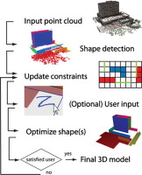Information
- Publication Type: Journal Paper (without talk)
- Workgroup(s)/Project(s):
- Date: May 2013
- Journal: Computer & Graphics
- Number: 3
- Volume: 37
- Pages: 137 – 147
- Keywords: Shape boundaries, Shape primitives; , Reconstruction;
Abstract
Shape primitives are a valuable input for reconstructing 3D models from point clouds. In this paper we present a method for clipping simple shape primitives at reasonable boundaries. The shape primitives, e.g. planes or cylinders, are 2D manifolds which are automatically detected in unstructured point clouds. Shape boundaries are necessary for generating valid 3D models from multiple shape primitives, because shape primitives possibly have dimensions of infinite extent or they are only partially present in the scene. Hints for reasonable boundaries of shape primitives are indicated by different input sources and constraints. Point clouds and range images provide information where shape primitives coincide with measured surface points. Edge detectors offer cues for surface boundaries in color images. The set of shape primitives is analyzed for constraints such as intersections. Due to an iterative approach, intermediate results provide additional constraints such as coplanar boundary points over multiple shape primitives. We present a framework for extracting and optimizing shape boundaries based on the given input data and multiple constraints. Further, we provide a simple user interface for manually adding constraints in order to improve the results. Our approach generates structurally simple 3D models from shape primitives and point clouds. It is useful for reconstructing scenes containing man-made objects, such as buildings, interior scenes, or engineering objects. The application of multiple constraints enables the reconstruction of proper 3D models despite noisy or incomplete point clouds.Additional Files and Images
Weblinks
BibTeX
@article{Reisner_2013_RSB,
title = "Reconstruction of Shape Boundaries with Multimodal
Constrains",
author = "Irene Reisner-Kollmann and Stefan Maierhofer and Werner
Purgathofer",
year = "2013",
abstract = "Shape primitives are a valuable input for reconstructing 3D
models from point clouds. In this paper we present a method
for clipping simple shape primitives at reasonable
boundaries. The shape primitives, e.g. planes or cylinders,
are 2D manifolds which are automatically detected in
unstructured point clouds. Shape boundaries are necessary
for generating valid 3D models from multiple shape
primitives, because shape primitives possibly have
dimensions of infinite extent or they are only partially
present in the scene. Hints for reasonable boundaries of
shape primitives are indicated by different input sources
and constraints. Point clouds and range images provide
information where shape primitives coincide with measured
surface points. Edge detectors offer cues for surface
boundaries in color images. The set of shape primitives is
analyzed for constraints such as intersections. Due to an
iterative approach, intermediate results provide additional
constraints such as coplanar boundary points over multiple
shape primitives. We present a framework for extracting and
optimizing shape boundaries based on the given input data
and multiple constraints. Further, we provide a simple user
interface for manually adding constraints in order to
improve the results. Our approach generates structurally
simple 3D models from shape primitives and point clouds. It
is useful for reconstructing scenes containing man-made
objects, such as buildings, interior scenes, or engineering
objects. The application of multiple constraints enables the
reconstruction of proper 3D models despite noisy or
incomplete point clouds. ",
month = may,
journal = "Computer & Graphics",
number = "3",
volume = "37",
pages = "137--147",
keywords = "Shape boundaries, Shape primitives; , Reconstruction;",
URL = "https://www.cg.tuwien.ac.at/research/publications/2013/Reisner_2013_RSB/",
}


 Paper
Paper
